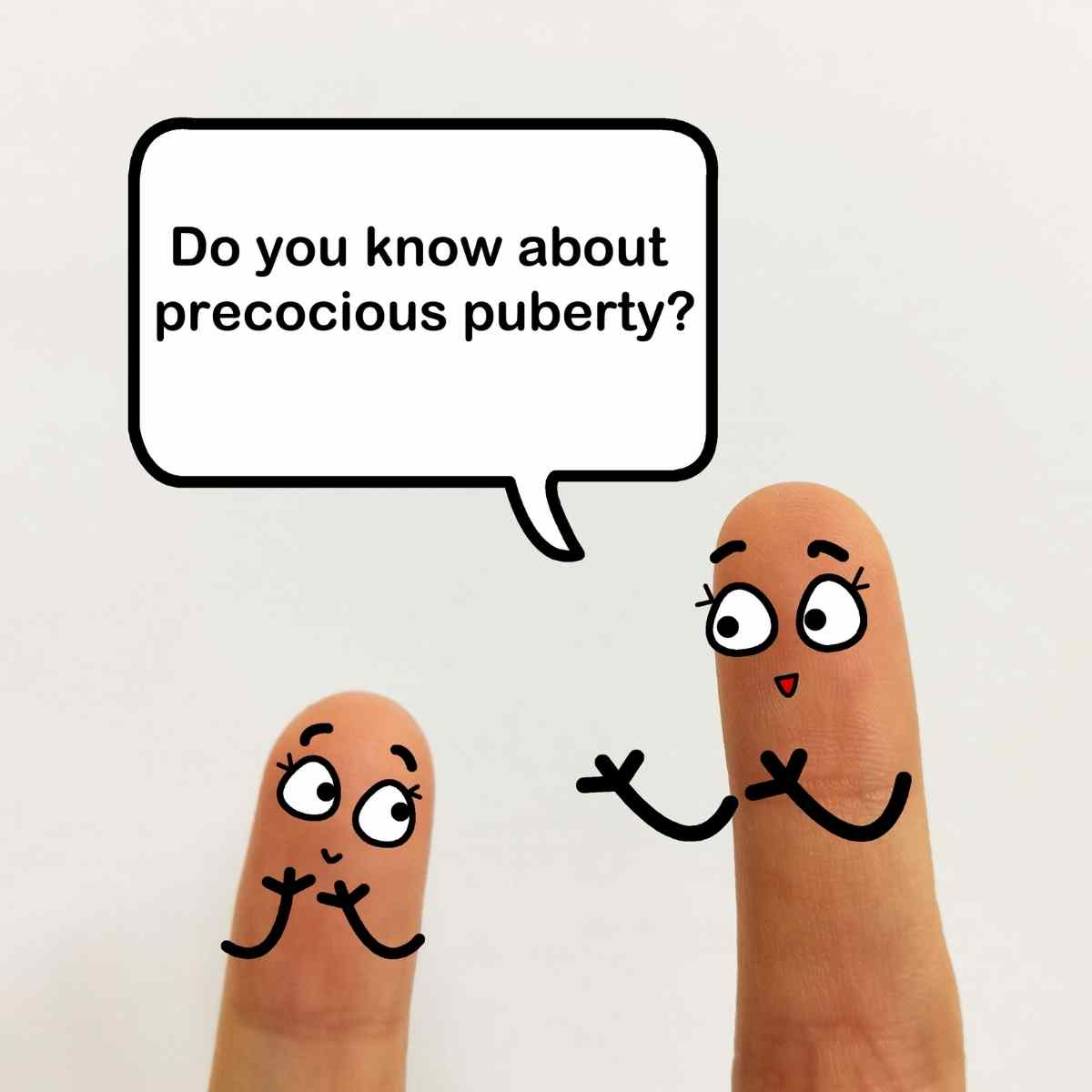Precocious Puberty: Causes & How to Avoid It
Please click here to read the full FTC Affiliate Disclosure policy.
- August 27, 2024 @ 14:11 pm EST
- comments

Precocious puberty (the development of the signs of puberty before age 8) has been on the rise for years. The incidence of precocious puberty is also much higher in girls than boys (10:1 rate of incidence). It’s basically a problem in girls, not boys. While the actual age of getting your period is not as drastically affected, pre-pubertal development is starting up much earlier now. An over-20-year-old article showed that over 15% of girls started showing signs of pubertal development by age 8! Another study says 1 in 5000-10,000 girls start to show signs of puberty before age 8. If you look at pre-pubertal development by age 9-10 (not precocious by definition), that incidence will go up much more. I personally don’t want my daughter showing signs of puberty by age 9 – it seems too early!
The whys are unclear and complex. There are some genetic/medical causes, but I think what we have to be concerned about is the environmental causes.
One likely cause of precocious puberty is obesity in girls, but not boys. Childhood obesity has been on the rise for years, so it can probably account for some of the increase in precocious puberty too. If the obesity is diet-linked, the fixes are clear, and make sense as general guidelines: more clean eating, cutting out processed food/sodas as much as possible, watch out for high fructose corn syrup, all while also bolstering a more positive body image (this is so important).
Environmental causes of precocious puberty
On Dairy consumption
If people are asked to name one thing they think causes early puberty, they tend to jump on milk (particularly that from cows treated with synthetic bovine growth hormone; rBST). First, any rBST in milk is destroyed during pasteurization, so it would not be active. Any attempt to associate hormone treatment of cows to earlier puberty thus is a total non-starter. But let’s look at milk itself.
As I dug in, it became clear that any links between milk consumption and earlier puberty are tenuous at best. This study argues for a weak link between the highest levels of milk consumption and a lower age at menarche. If this association is indeed real, it may be due to the biochemistry of milk itself: milk (and other animal products) increase the levels of insulin-like growth factor I (IGF-1). IGF-1 is a primary mediator of growth hormone, and influences growth and the timing of puberty. So while it has a normal role in health, too much is bad and is incidentally also linked to certain cancers in older people.
The more milk you drink, the greater your IGF-1 levels. Interestingly, the same association does not seem to hold true for yogurt or cheese, according to this study. There are links between milk consumption and certain cancers, as well. Since my daughter exclusively has yogurt every day and almost no milk, I looked further, and found this contradicting study which says both milk and yogurt (but not cheese) consumption increase the circulating levels of IGF-1.

What’s my take-home from this? Have dairy, sure, but in moderation. You can go nuts with cheese, thank god! Some of what I’ve covered argues for being vegan. That’s nice in theory, but far less unappealing/difficult in practice (IMO). So if you love your animal products, the BEST thing to give your child is a balanced diet, which gets in balanced nutrition from not just animal proteins (dairy, meat, etc, all of which increase IGF-1 levels) but also plant sources. In the words of my 7-yo daughter, be an omnivore!
Should you focus on the source of the dairy/animal products itself? Modern-day large-scale farming employs abominable practices, which on the whole affect product quality in many ways. Where there is no link between hormone treatment of animals and puberty, it makes so much sense to get your animal products from pasture-raised, humanely farmed animals, IF your budget allows for it easily. Tenuous scientific associations aside, it’s good for the animals, it’s good for the earth, and what you eat ends up tasting SO much better. I recently started buying my meats online from this farm that produces pasture-raised meats using heirloom varieties of animals, and the quality is SO, SO good! Never going back to the supermarket stuff.
Endocrine Disrupting Chemicals (EDCs)
As the name suggests, these are chemicals that mess with your hormonal (endocrine) system in many ways, and can theoretically hasten the onset of signs of puberty. Where do you find them, you ask? The answer is everywhere. Some EDCs are naturally occurring (eg phytoestrogens in soy), and the vast remaining majority are manmade and are found in furniture, food packaging, car seats, personal care items, flooring, and so on.
Phthalates
These have been linked to premature breast development and, unfortunately, are in so many sources that it’s impossible to avoid completely.
1) Phthalates in Vinyl flooring – here is a good resource on this, and it’s one to keep in mind especially if you have a young child crawling on floors. This blog talks about choosing phthalate-free options.
2) Phthalates in personal use cosmetics: It is a possibility that excessive use of products containing phthalates during pregnancy can affect pubertal timing in girls born of those pregnancies. Sensible avoidances: cut down on perfume, nail polish, and cosmetics use during pregnancy. Especially perfume use. Check the ingredients of your body moisturizers during this time. I was horrified to see parabens and phthalates (parfum) in a Neutrogena body oil I had used while pregnant! Try using plain oil (eg almond oil) mixed with water to make an emulsion. You can even try making your own body moisturizer with oil and shea butter, but avoid adding essential oils, as they can also contain endocrine-disrupting chemicals.
I personally stopped using perfumes years ago after what I had read. It helped that most perfumes gave me headaches. Still, that’s a personal choice, and there’s not really data to show that it is unsafe. The FDA deems phthalate use in cosmetics and perfumes safe based on the available data. It’s only during pregnancy that it gets more questionable. But maybe don’t hug your kids immediately after applying perfume?

It goes without saying that young girls should not use perfume or fragrance sprays, given how sensitive they are to endocrine disruption. I personally would not allow young girls to use makeup, especially the cheap stuff made in China – forget about phthalates, it can be heavily contaminated with asbestos. The same goes for pretend play makeup. I worry about the face painting kits too – that said, occasional face painting is probably fine. Keep nail polish use in kids infrequent, and use low-toxic nail paints. Ella + Mila (17-free) and Cirque Colors (10-free) look like 2 good brands. I’ve used Cirque Colors and love it.
People have asked for a good moisturizer for kids – this is what I have at home – it’s free of parabens and fragrance, and does a good job in winter. I usually don’t apply anything on her face, but if I need to, I use the Glow turmeric and rosehip oil.
3) Phtlalates in food: Food can be a source of ortho-phthalates, largely through packaging or food processing equipment. For example, milk can be a source due to the PVC pipes used for milking, or for milk transport in larger farms. But you can’t go back to the olden days of food production where phthalate contamination was not an issue, unless you quit modern life as we know it.
This post is about pointing out the prudent, easier-to-make choices. Basically, the data shows that eating out (especially eating out from fast food restaurants) tends to increase phthalate levels. So if you regularly eat McDonald’s, you may want to try to mix it up and eat more at home – for a million reasons other than just the phthalates and PFAS in your food packaging! Using local farmer’s markets may also cut down on exposures, given that far less packaging is used.
We do far too much takeout in my house (mostly sushi, which is pretty healthy). Still, this is where I need to check myself, and eat the home-cooked stuff more. Little habits can also count. Don’t have the soy sauce from the plastic packets, buy the soy sauce in glass bottles. Never microwave takeout containers because that increases the leaching of chemicals from them. Super hot takeout ladled into plastic containers is not great either. But as long as it’s not too regular an occurrence, it’s probably no big deal.
Flame-retardant chemicals
Polybrominated diphenyl ethers (PBDEs) widely used as flame retardants have been linked to endocrine disruption and precocious puberty. The bad news is there really is no escaping flame retardants. They are literally everywhere. Nor can I suggest many sensible and easy avoidances to reduce exposure. The ONE thing that comes to mind is car seats – car seats are a source of flame retardants, sure. The one thing I limited greatly was letting her eat in her car seat. I’d always imagine her dropping her snack on it, then picking it up covered in flame retardants and eating it. Barf.

As I researched for this writeup, it turns out there are a few “green” car seats where the manufacturers have committed to eliminating flame retardants – for example, the Safewash line by Britax. You can get more information on that here. Still, flame retardant exposure through car seats is just a drop in the bucket compared to all the exposures nowadays. I’d make this just one of the factors to consider when deciding which car seat to buy.
Isoflavones (Phytoestrogens) in soy
People have done many studies to see whether a high intake of soy (either early in life through infant formulas or through childhood) is linked to precocious puberty. So far, while sometimes certain isoflavones are higher in girls with precocious puberty, there does not seem to be a link between soy intake and precocious puberty on the whole. This blog has a balanced take on it. So go ahead and have soy in the form of tofu (or better, fermented soy products such as tempeh), but as I said with milk consumption, try to keep it mixed up. Maybe avoid soy-based infant formulas to be on the safe side.
Water as a source of EDCs
Flame retardants, plasticizers, PFAS, and other chemicals that affect human health can and do end up in drinking water supplies. This review on risk assessment of EDCs in drinking water drives home the point that drinking water is not routinely monitored for EDC levels, while it is for lead, turbidity, etc. You can check your local water supply here, but there are several limitations in the data obtained, including lack of recent testing, and whether the testing actually includes testing for EDCs.
What you can do is filter your water. I don’t love fridge or Brita filters (also don’t like the fact that it collects in plastic), and have instead installed a reverse osmosis system. Objectively speaking, I hate the taste of tap water in my area. I don’t really love the taste of fridge or Brita-filtered water either, but my RO water tastes good. Having some sort of filtration is much better than having none, so if you don’t want to spring for an RO system, at least try the other options.
Plus, a gentle reminder that it’s generally not a good idea to drink bottled water too regularly, especially if said water is left in a hot garage or car in the summer months.
In Summary
It’s likely that increased exposure to endocrine-disrupting chemicals (EDCs) in addition to the increase in diet-linked childhood obesity is responsible for the trend of prepubertal development in shockingly young children. But beyond that, it’s impossible to tease any contributing factors apart further. It’s also impossible to fully avoid EDCs. Remember, despite all of our kids walking around with probably detectable levels in their blood, they are largely healthy! So don’t freak out, and see the below guidelines to reduce your EDC exposure. Most of these guidelines also promote living healthier on the whole, protecting your environment, and treating the animals in our world better:
➤➤Eat at home more, cut down on fast food and sugary drinks (especially those containing high fructose corn syrup; did you know Mexican coke is sweetened with cane sugar instead of high fructose corn syrup?)
➤➤Have a varied diet. Too much of ANYTHING (even something like milk) is not great – mix it up. If you need to have a lot of animal products in your diet (like I do), balance it by introducing more whole grain and plant products
➤➤ Avoid microwaving in plastic. Never microwave takeout cardboard containers (see people do this all the time)
➤➤Try to shop local, to reduce the amount of packaging in your life
➤➤Filter your water & cut down on bottled water use (avoid drinking bottled water lying in a hot area)
➤➤If you have a young child crawling around on the floors especially, try to avoid lower-end laminate flooring.
➤➤Cut down on use of perfumes and cosmetics while pregnant
➤➤Cut down or don’t allow young children to use perfumes or cosmetics; if you do use it, then choose higher-end products (See my note on nail polishes, for example)















